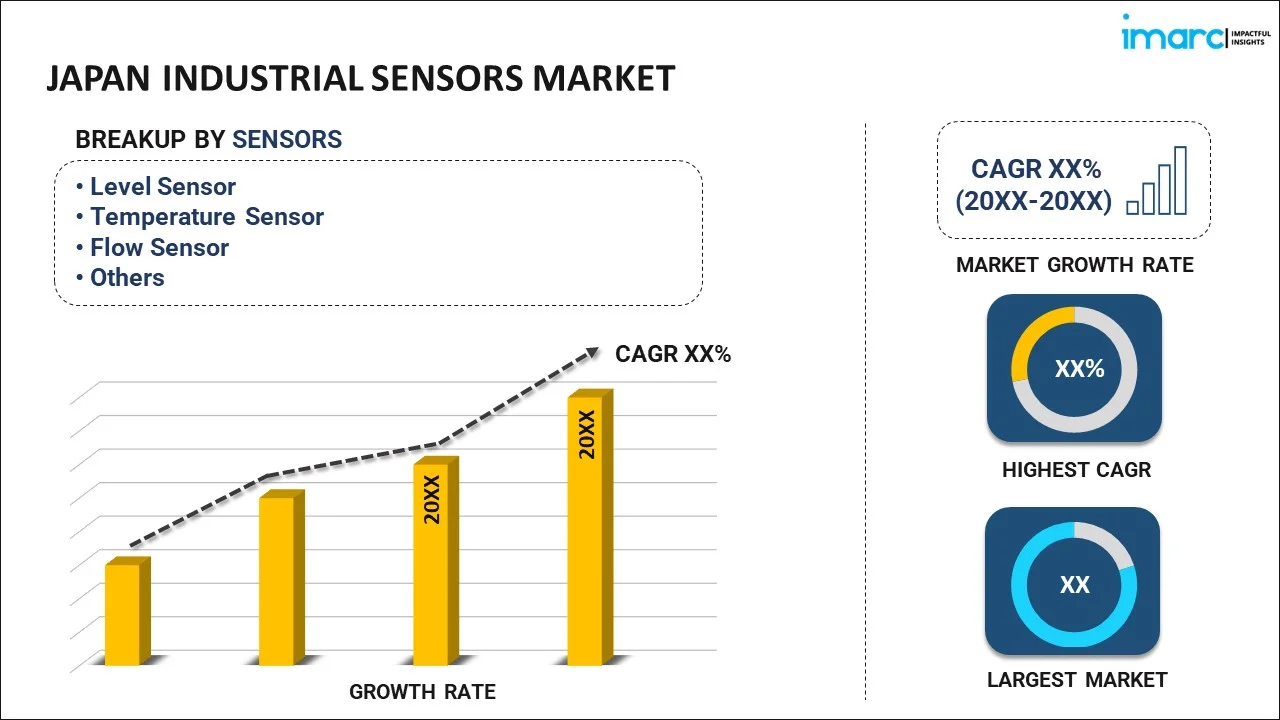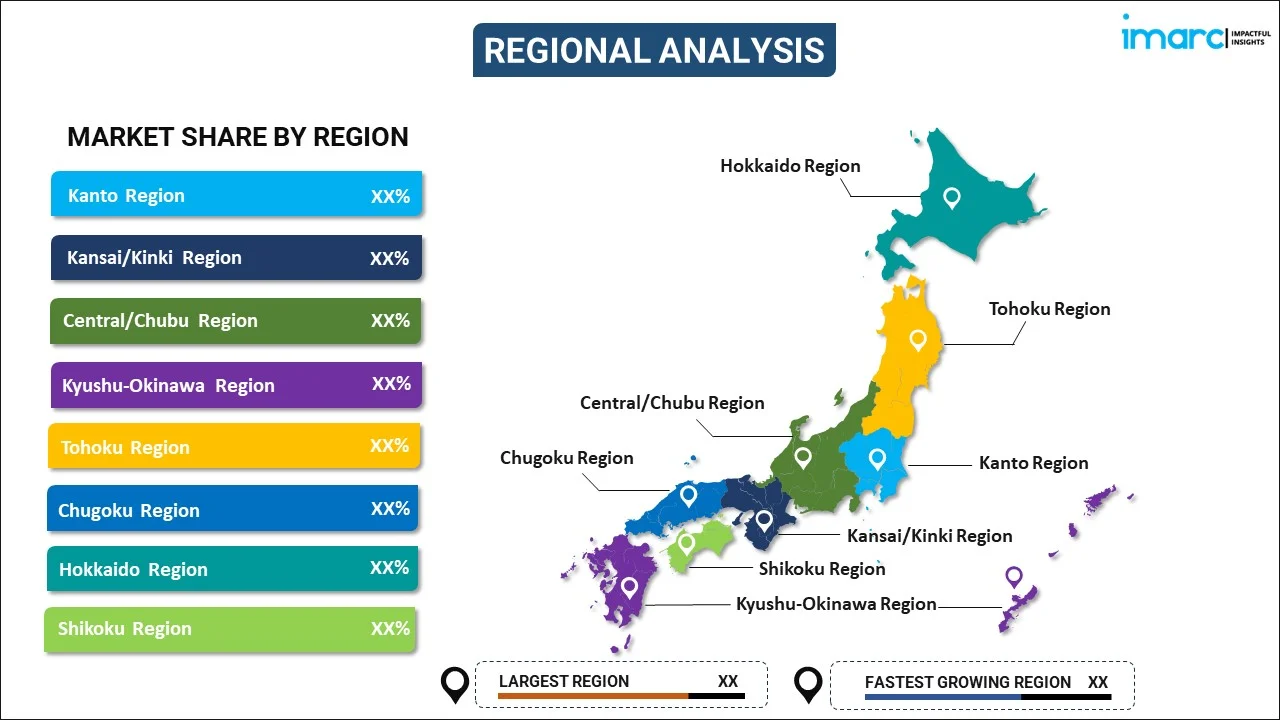
Japan Industrial Sensors Market Report by Sensor (Level Sensor, Temperature Sensor, Flow Sensor, Position Sensor, Pressure Sensor, Force Sensor, Image Sensor, Gas Sensor, and Others), Type (Contact, Noncontact), End Use Industry (Mining, Oil and Gas, Manufacturing, Chemical, Energy and Power, Healthcare, Water and Wastewater Treatment, Aerospace and Defense, and Others), and Region 2025-2033
Market Overview:
Japan industrial sensors market size reached USD 1.4 Billion in 2024. Looking forward, IMARC Group expects the market to reach USD 4.2 Billion by 2033, exhibiting a growth rate (CAGR) of 12.2% during 2025-2033. The growing healthcare industry and the rising demand for medical sensors used in devices such as patient monitors and wearable health tech, is driving the market.
|
Report Attribute
|
Key Statistics
|
|---|---|
|
Base Year
|
2024 |
|
Forecast Years
|
2025-2033
|
|
Historical Years
|
2019-2024
|
| Market Size in 2024 | USD 1.4 Billion |
| Market Forecast in 2033 | USD 4.2 Billion |
| Market Growth Rate (2025-2033) | 12.2% |
Industrial sensors are devices used in various manufacturing and industrial processes to monitor and collect data about the physical or chemical properties of the environment, machinery, or products. These sensors play a crucial role in automation, control systems, and quality assurance. Industrial sensors come in a wide range of types, including temperature sensors, pressure sensors, proximity sensors, flow sensors, and more. They can detect changes in parameters like temperature, pressure, humidity, position, and motion, providing real-time information to machines and control systems. The data collected by industrial sensors is used for process optimization, equipment maintenance, and ensuring product quality. For example, temperature sensors can help maintain ideal operating conditions in industrial processes, while proximity sensors can detect the position of objects on a production line, enabling precise automation. Overall, industrial sensors are essential tools in modern manufacturing and industrial settings, enhancing efficiency, safety, and product consistency while reducing downtime and waste.
Japan Industrial Sensors Market Trends:
The industrial sensors market in Japan is experiencing robust growth, primarily driven by several key factors. Firstly, the increasing adoption of automation and Industry 4.0 technologies is a significant driver. As industries seek to enhance efficiency and productivity, the demand for sensors that can collect and transmit real-time data is rising steadily. Furthermore, the expanding Internet of Things (IoT) ecosystem is playing a pivotal role. Through seamless connectivity, sensors enable the monitoring and control of machinery and processes remotely, contributing to operational optimization. Additionally, stringent government regulations and environmental concerns are propelling the market forward. Industries are compelled to employ sensors for environmental monitoring and compliance reporting, fostering the adoption of environmental and gas sensors. Moreover, the expanding automotive sector, with the growing incorporation of advanced driver assistance systems (ADAS) and autonomous vehicles, which rely heavily on sensors for safety and navigation, is expected to drive the industrial sensors market in Japan during the forecast period.
Japan Industrial Sensors Market Segmentation:
IMARC Group provides an analysis of the key trends in each segment of the market, along with forecasts at the country level for 2025-2033. Our report has categorized the market based on sensor, type, and end use industry.
Sensor Insights:

- Level Sensor
- Temperature Sensor
- Flow Sensor
- Position Sensor
- Pressure Sensor
- Force Sensor
- Image Sensor
- Gas Sensor
- Others
The report has provided a detailed breakup and analysis of the market based on the sensor. This includes level sensor, temperature sensor, flow sensor, position sensor, pressure sensor, force sensor, image sensor, gas sensor, and others.
Type Insights:
- Contact
- Noncontact
A detailed breakup and analysis of the market based on the type have also been provided in the report. This includes contact and noncontact.
End Use Industry Insights:
- Mining, Oil and Gas
- Manufacturing
- Chemical
- Energy and Power
- Healthcare
- Water and Wastewater Treatment
- Aerospace and Defense
- Others
The report has provided a detailed breakup and analysis of the market based on the end use industry. This includes mining, oil and gas, manufacturing, chemical, energy and power, healthcare, water and wastewater treatment, aerospace and defense, and others.
Regional Insights:

- Kanto Region
- Kansai/Kinki Region
- Central/ Chubu Region
- Kyushu-Okinawa Region
- Tohoku Region
- Chugoku Region
- Hokkaido Region
- Shikoku Region
The report has also provided a comprehensive analysis of all the major regional markets, which include Kanto Region, Kansai/Kinki Region, Central/ Chubu Region, Kyushu-Okinawa Region, Tohoku Region, Chugoku Region, Hokkaido Region, and Shikoku Region.
Competitive Landscape:
The market research report has also provided a comprehensive analysis of the competitive landscape in the market. Competitive analysis such as market structure, key player positioning, top winning strategies, competitive dashboard, and company evaluation quadrant has been covered in the report. Also, detailed profiles of all major companies have been provided.
Japan Industrial Sensors Market Report Coverage:
| Report Features | Details |
|---|---|
| Base Year of the Analysis | 2024 |
| Historical Period | 2019-2024 |
| Forecast Period | 2025-2033 |
| Units | Billion USD |
| Scope of the Report | Exploration of Historical Trends and Market Outlook, Industry Catalysts and Challenges, Segment-Wise Historical and Future Market Assessment:
|
| Sensors Covered | Level Sensor, Temperature Sensor, Flow Sensor, Position Sensor, Pressure Sensor, Force Sensor, Image Sensor, Gas Sensor, Others |
| Types Covered | Contact, Noncontact |
| End Use Industries Covered | Mining, Oil and Gas, Manufacturing, Chemical, Energy and Power, Healthcare, Water and Wastewater Treatment, Aerospace and Defense, Others |
| Regions Covered | Kanto Region, Kansai/Kinki Region, Central/ Chubu Region, Kyushu-Okinawa Region, Tohoku Region, Chugoku Region, Hokkaido Region, Shikoku Region |
| Customization Scope | 10% Free Customization |
| Post-Sale Analyst Support | 10-12 Weeks |
| Delivery Format | PDF and Excel through Email (We can also provide the editable version of the report in PPT/Word format on special request) |
Key Questions Answered in This Report:
- How has the Japan industrial sensors market performed so far and how will it perform in the coming years?
- What has been the impact of COVID-19 on the Japan industrial sensors market?
- What is the breakup of the Japan industrial sensors market on the basis of sensor?
- What is the breakup of the Japan industrial sensors market on the basis of type?
- What is the breakup of the Japan industrial sensors market on the basis of end use industry?
- What are the various stages in the value chain of the Japan industrial sensors market?
- What are the key driving factors and challenges in the Japan industrial sensors?
- What is the structure of the Japan industrial sensors market and who are the key players?
- What is the degree of competition in the Japan industrial sensors market?
Key Benefits for Stakeholders:
- IMARC’s industry report offers a comprehensive quantitative analysis of various market segments, historical and current market trends, market forecasts, and dynamics of the Japan industrial sensors market from 2019-2033.
- The research report provides the latest information on the market drivers, challenges, and opportunities in the Japan industrial sensors market.
- Porter's five forces analysis assist stakeholders in assessing the impact of new entrants, competitive rivalry, supplier power, buyer power, and the threat of substitution. It helps stakeholders to analyze the level of competition within the Japan industrial sensors industry and its attractiveness.
- Competitive landscape allows stakeholders to understand their competitive environment and provides an insight into the current positions of key players in the market.
Need more help?
- Speak to our experienced analysts for insights on the current market scenarios.
- Include additional segments and countries to customize the report as per your requirement.
- Gain an unparalleled competitive advantage in your domain by understanding how to utilize the report and positively impacting your operations and revenue.
- For further assistance, please connect with our analysts.
 Inquire Before Buying
Inquire Before Buying
 Speak to an Analyst
Speak to an Analyst
 Request Brochure
Request Brochure
 Request Customization
Request Customization




.webp)




.webp)












